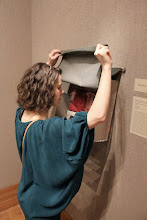The film, Pina, directed by Wim Wenders makes you cry, but makes you laugh more. This documentary exhibits the results of Pina Bausch, an artist courageous enough to search deep for personal truth. Attempts, brutal and desperate, are what it means to be human and these attempts are never perfect, rarely beautiful and often times awkward, futile and silly. But ultimately, in Bausch’s hands, these attempts are visual gold in spite of themselves, because their honesty touches the brink between joy and sorrow, confusing viewers as to whether to laugh or to cry.
Pina Bausch and Wim Wenders were originally intending to collaborate on this film. But because of Bausch’s sudden death before filming it ended up being an eulogy to her. There is a fresh sadness to the film seen through interviews with the dancers and their dealings with the unexpected tragedy.
The film was discreet concerning Bausch’s personal life and herself as an artistic personality. This was her wish in the collaboration with Wenders. There were no interviews, only quick images and video clips of Bausch. But those few glimpses were captivating. When she was young there was cunning in her eyes and her smile was sexy with irony. Then when she was older, with a face of defining lines, she had kindness in her eyes and openness in her smile.
But the documentation was created to focus on dance. Knowing nothing about Bausch, we are left with the bare bones of dancers who knew her and what she created through their movement. According to a few of their accounts she was a careful listener, commanding respect with an aloof air of seeing to the core of people. She uncovered and revealed bits and pieces from her dancers that they did not know they possessed. She was a facilitator. Bausch created dance out of exasperation with words because it allows meaning to exist without the limitation of one definition at a time.
Pina starts with the 3-D effect in great use. Swooping in on the male and female dancers (who are barefoot on a stage of fresh soil) getting close to the distinct faces, whom we later meet individually. Wenders has an affinity for a dark circus and the opening scene reminds viewers who is directing. The dancers are wet with sweat and dirt and the camera exaggerates the strange in the dancers faces and muscled, nearly naked bodies. This opening dance was abrasive to watch because of violent, self-inflicted gestures that were repeated in mass until the dancers looked bloody and beat, though it was only sweat and soil and they were their own perpetrators. The collective groups, separated into genders, seemed like an army, but instead of directing the violence outward, it was self-inflicted.
The thing that Bausch and Wenders share is an affinity for the grotesquely beautiful. The swiveling of hips in a simultaneously seductive and ridiculous way. The sexy and the silly. The old and the young. The constructed and the natural. Wenders highlights Bausch’s sentiment by weaving his typically outstanding musical selection through spliced moments of dance and interview. Wenders loves to take intimate, private moments to public places. And infuse everyday, normal activity with magic, whimsy, humor and sadness at the same time. These overlapping meanings point to life the way poetry does, without stating exactly, but hinting at the essential.
What struck me immediately about Bausch’s dance was her bold inclination to expose human futility, with humor and pain. The pitiful, willful trying humans do everyday was shown over and over in different dances. A body smacking face first into a wall. Falling, to get back up to fall again and again and again and again. To grossly generalize it can be said that life is encapsulated in these repeated scenes of silly, but silliness for awesome’s sake.
Beautiful free-flowing hair is a Bausch trademark (like trains for Wenders). The women’s loose long hair is at once beautiful and distracting. It gets sweaty and sticks to their faces. They must be aware of it and where it will fall, using it as another limb. Yet it is just one more obstacle for the dancers to encounter and try to surmount. Like dancing through water, or on wet stones, in soil, grass, close to a deep abyss, with other’s bodies or ultimately just with one’s own, the goal of course is an attempt to succeed. Yet what we see when we watch Bausch’s dance is failed attempts, over and over. That is certainly not the pretty package of success but it is beautiful and laughable and livable truth.

No comments:
Post a Comment